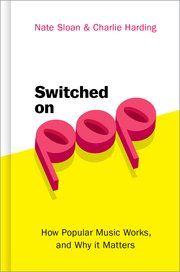Book Review: "Switched on Pop"
How a university press can find it hard to execute mass market books

We hear a lot about how publishers can retool their content for the masses, but this is usually easier said than done. From language editing to marketing, publishing for the masses takes specialized skills. A new book from Oxford University Press (OUP) provides a concrete example in how seemingly simple standards of fit and finish can elude presses who don’t go mass market routinely.
The book is called “Switched on Pop,” and comes from the hosts of the podcast of the same name — Nate Sloan and Charlie Harding. It’s a fun read, but the book’s production values underscore in some ways the difficulty even large, sophisticated university presses can have in translating works to the general public.

In this case, the first clue is something you may detect in the image above — the binding. See that vertical line? It’s a giveaway that we’re looking at a textbook binding. When I first saw it online, I wondered why it would even be there. Did they actually have cover art with that line there? I suspected something about the book’s physical manifestation was off.
When I received the book as a gift this Christmas, my suspicions were confirmed. “Switched on Pop” feels like a book you’d get out of an elementary school library — sized for small hands, with a cheesy textbook cover, a cheap binding, and low-quality paper. I don’t know why OUP didn’t do better, but I’ve found that OUP books often come out feeling a little slapdash when we’re talking production values.
These production mistakes detract from an otherwise commendable book. The content of “Switched on Pop” is generally strong. Harding and Sloan tackle various musical motifs through the prisms of modern pop songs. This is a smart approach, and helps deepen your appreciation for some modern pop you might otherwise dismiss (Carly Rae Jepsen’s “Call Me Maybe” is a poignant example), while showing you how flexible these motifs can be. The authors often tie them back to forebears in swing, jazz, classical, or earlier pop music. The motifs doth rule!
Contrasting motifs proves informative. For me, this comes to a head late in the book, when the authors compare Toby Keith’s “Made in America” with the song of the same name by Kanye West, Jay-Z, and Frankie Ocean. The soundscapes, lyrics, and meanings of the songs provide counterpoints that are both expected and unexpected, and the way musical appropriation across cultures is so rampant in these songs and their forebears emphasizes how “Made in America” has a subtextual meaning in both songs. It’s a fascinating chapter.
The focus on modern pop does have some downsides, however, as nearly everything is about producers, songwriters, song structure, and singers — the main elements of modern pop. Bands and instrumentalists get short shrift, often passed off as “then there’s a guitar solo” or “the toms pound to underscore the moment.” Certain pop songs are distinctive because of choices or abilities of the players. Some of the compositions use chord structures or rhythmic motifs that are a little bizarre and hard to play, but the challenges placed before performers other than singers or participants other than producers get barely a mention. In that regard, “Switched on Pop” can seem a bit more remote and academic than I think the authors wish. (For a more down-to-earth take on playing music, I’d recommend Steve Gorman’s “Hard to Handle: The Life and Death of the Black Crowes.” It’s superb.)
That set of caveats aside, “Switched on Pop” is well worth reading if you like music, feel that modern pop is hard to appreciate, and/or like reading analyses of art, music, or literature.
Podcasts are thriving along with “explainer journalism.” People like and need the anchors interpreters and teachers provide in the maelstrom of modern information cascades. Harding and Sloan do a very good job on their podcast interpreting and explaining trends and themes in modern pop, and their book is a great expansion and distillation of this. Like good pop, it’s clever, clear, enjoyable, and has more depth than you might at first expect.
Too bad this book’s publisher put the contents in the kind of package you’d expect to find in a 4th grader’s backpack.
Recommended content, but be prepared for a cheap-feeling book.